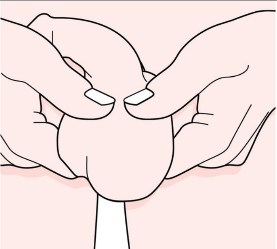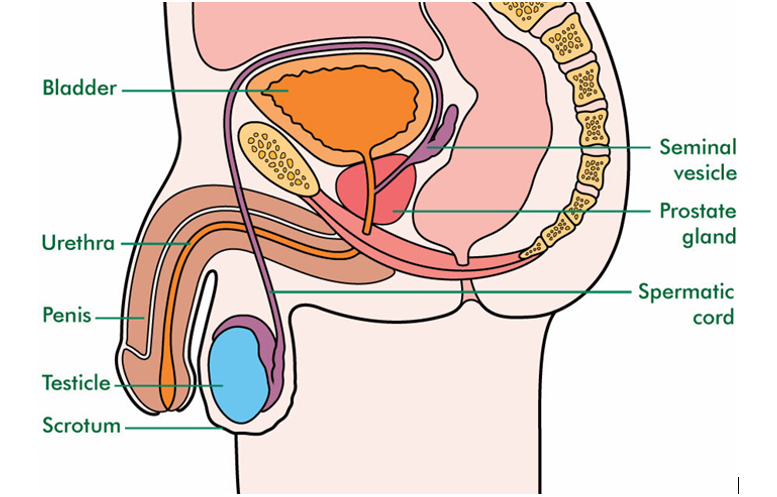Testicular cancer starts in one of the testicles (also called the testes). Each year in the UK, around 2,300 men are diagnosed with testicular cancer. Testicular cancer can affect men, trans (transgender) women, and anyone assigned male at birth. It is more common in white men and younger to middle-aged men. Testicular cancer is usually curable.
How to check for testicular cancer
From puberty onwards, it is important to check your testicles regularly. Testicular cancer is usually always cured but it is easier to treat when it is diagnosed early.
Checking for testicular cancer is sometimes called testicular self-examination. Doing this regularly means you soon get to know what feels normal for you. A normal testicle should feel smooth and firm, but not hard.
Hold your scrotum in the palm of your hand. Use your fingers and thumb to examine each testicle. You should feel for:
- lumps or swellings
- anything unusual
- differences between your testicles.
It is normal for the testicles to be slightly different in size. It is also normal for one to hang lower than the other.
The epididymis (tube that carries sperm) is behind the top of each testicle. It feels like a soft, coiled tube. It is common to get harmless cysts or benign lumps in the epididymis. Treatment for these may vary.
Other conditions can cause lumps or swellings, and most lumps are not cancer. But it is important you get your doctor to check anything unusual as soon as possible.
Am I at risk?
The exact cause of testicular cancer is not known, however certain risk factors may increase the chance of developing it. These are:
- Undescended testicle (known as cryptorchidism)
- Family history– there is a slightly higher risk if a brother or father has had testicular cancer
- Carcinoma in situ (CIS)– abnormal cells in the testicle
- Cancer in the other testicle
- Ethnicity (it is more common in white males)
- Height– you may have a higher risk of testicular cancer if you are taller than average
- Human immunodeficiency virus (HIV)– if you are HIV positive you have an increased risk of developing testicular cancer.
For more information on the risk factors for testicular cancer, please follow this link.
Types of testicular cancer
Sometimes testicular cancer can spread to lymph nodes (glands) at the back of the tummy. These are called the retroperitoneal lymph nodes.
There are 2 main types of testicular germ cell tumours:
- Seminoma – Seminomas usually happen in men aged 15 to 55. About 40 to 45 in 100 (40 to 45%) of men with testicular cancer have a seminoma.
- Non-seminoma – Non-seminomas most often affect men aged 15 to 35. They happen in about 40 to 45 in 100 (40 to 45%) of men with testicular cancer.
Testicular cancer is a general term for all types of testicular cancer. Most of these cancers develop from germ cells in the testicles. So they are also sometimes called germ cell tumours (GCTs).
Non-seminomas are made of different types of cells. They can be made of just one cell type, or they may be made of a mixture. They include:
- Teratomas
- Embryonal tumours
- Yolk sac tumours
- Choriocarcinomas.
Sometimes, non-seminomas can be combined with seminomas.
Rarer types
- Sometimes, the cancer found in the testicle is not a germ cell tumour, but another type of cancer. These include a type of cancer called Non-Hodgkin lymphoma. Other rare types are Leydig cell tumours and Sertoli cell tumours.
Symptoms of testicular cancer
The most common symptom is a lump in a testicle. But there may also be other symptoms, depending on whether the cancer has spread outside the testicle.
Symptoms can include:
- swelling or a lump in a testicle, which is usually painless – occasionally the swelling may suddenly increase in size and become painful
- a dull ache or pain, or heaviness in the scrotum
If the cancer has spread to the lymph nodes or other parts of the body, there may be some of the following symptoms:
- Pain in the back, groin, or lower abdomen – this can be caused by the spread of the cancer to lymph nodes in the back of the abdomen.
- A cough, breathlessness or difficulty swallowing if lymph nodes in the chest area are affected. Rarely, if the cancer has spread to the lungs, coughing and breathlessness may be the main symptoms.
- Nipple/breast tenderness or breast swelling (gynaecomastia) – this isn’t common but can be caused by hormones produced by the cancer.
All the symptoms mentioned here can be caused by conditions other than cancer. But it is important to see your GP and get them checked.
Patient information
For more information from Macmillan regarding testicular cancer, please follow this link.
For more information from Cancer Research UK regarding testicular cancer, please follow this link.

